Using Urban Building Energy Models for the Development of Sustainable Island Energy Systems
Abstract
1. Introduction
2. Case Study
3. Materials and Methods
3.1. Data Collection and Preparation
3.2. Data Inputs and Tool Configuration
3.2.1. City Energy Analyst
- Each building use type was manually assigned according to the classification of Salvador [19], including the options described in left column of Table 1. These changes were made only for the buildings within the “Historic urban nucleus of Vila do Corvo”. The use type of the remaining buildings was assigned according to additional information available, and otherwise as SINGLE RESIDENTIAL buildings.
- Two additional building use types were created based on the classification of Salvador [20]: RUIN—this category included unoccupied and ruined buildings, with all loads set to zero implying no consumption; and CHURCH—derived from the OFFICE use type, characterizing the schedules of religious buildings.
- Considering that over 90% of the houses have two above-ground floors [19], all buildings were set with two above-ground floors and a height of 6 m. Similarly, the values for below-ground properties were set to zero in every building.
- For SINGLE RESIDENTIAL buildings, their occupancy, setpoint, and setback temperatures were adjusted given the common house temperatures in Portugal, where heating was set to start below 16 °C and cooling above 26 °C. The occupancy density was changed to 56 occ/m2 to approximately match the population.
- The supply system technologies for water, heating, and space comfort were configured to electrify every energy service in the buildings using heat pumps. The case of water heating considered a demand for medium-temperature water (up to 45 degrees) using water–water heat pumps, while air–air heat pumps were considered only for space heating.
- The energy consumption of PARKING properties was set to zero due to the lack of electric mobility on the island, and the buildings in this category are typically used for storage, generally lacking air conditioning and using minimal electricity for lighting.
- Additional changes to the default building database included: a reduction of 50% in electrical needs of appliances (to 3.5 W/m2), identical temperature settings to all residential buildings, and schedule adjustments during weekends to reflect higher attendance, according to Portuguese culture.
3.2.2. EnergyPLAN
- Demand—the total electric demand fed to the model was calculated from the CEA results to obtain the district hourly (kWh) and total energy demand (equal to 1.74 GWh/year). The input files for this model were created using the Python programming language to sum the electric demand of all the buildings in each hour of the year and generate the input distribution file, which had to meet the criteria first, i.e., distribution files in “.txt” format containing one column with approximately 8784 rows corresponding to the total hours in a 366-day year. Both hourly and annual values remained equal in the three scenarios proposed during the analysis in this model.
- Variable Renewable Electricity—this option required specifying the installed capacity, stabilization profile, and distribution generation files of each renewable production technology, which considered three different scenarios: one scenario considering optimal solar and storage capacities according to the tool, one considering the same solar power constraints as in the CEA model, and one included wind power generation. Similarly to the demand files, the PV generation profiles were generated using the output results of CEA, while the wind power generation profiles were calculated using the wind speed recorded in the typical meteorological year (TMY) by EnergyPlus weather files.
- Balancing and Storage—in this option the only parameter considered was electric storage, which represents a generic storage technology able to charge and discharge a fixed storage capacity, with specific efficiencies. As in previous models, the Tesla Powerwall+ was the selected battery technology to feed the parameters of the model; e.g., according to the specifications of the manufacturer, it has a charge and discharge capacity of 7 kW (with both efficiencies equal to 90%) and a fixed storage capacity of 7.898 kWh per unit [23].
3.3. Validation of Data and Results
4. Results
4.1. City Energy Analyst
4.2. EnergyPLAN
5. Discussion
6. Conclusions
Author Contributions
Funding
Data Availability Statement
Conflicts of Interest
References
- Ritchie, H.; Rosado, P.; Roser, M. Energy Production and Consumption. Our World in Data. 2020. Available online: https://ourworldindata.org/energy-production-consumption (accessed on 23 June 2023).
- Marczinkowski, H.M.; Alberg Østergaard, P.; Roth Djørup, S. Transitioning Island Energy Systems—Local Conditions, Development Phases, and Renewable Energy Integration. Energies 2019, 12, 3484. [Google Scholar] [CrossRef]
- Directorate General for Energy. Energy Communities. European Comission. 2024. Available online: https://energy.ec.europa.eu/topics/markets-and-consumers/energy-communities_en (accessed on 23 June 2023).
- Lund, H. Chapter 4—Tool: The EnergyPLAN Energy System Analysis Model. In Renewable Energy Systems, 2nd ed.; Academic Press: Boston, MA, USA, 2014; pp. 53–78. [Google Scholar] [CrossRef]
- Reia, C.S.F. Sistema Eletrico da Ilha do Corvo: Estudo de um Sistema Baseado em Renovaveis com Armazenamento. Master’s Thesis, University of Lisbon, Faculty of Science, Department of Geography, Geophysics and Energy Engineering, Lisboa, Portugal, 2021. [Google Scholar]
- Alves, M.; Segurado, R.; Costa, M. Increasing the penetration of renewable energy sources in isolated islands through the interconnection of their power systems. The case of Pico and Faial islands, Azores. Energy 2019, 212, 502–510. [Google Scholar] [CrossRef]
- Alves, M.; Segurado, R.; Costa, M. On the road to 100% renewable energy systems in isolated islands. Energy 2020, 198, 117321. [Google Scholar] [CrossRef]
- Monteiro, D.P.A.P. 100% Renewable Energy System for the Autonomous Region of Madeira in 2050. Master’s Thesis, Instituto Superior Técnico, University of Lisbon, Mechanical Engineering, Lisboa, Portugal, 2021. [Google Scholar]
- Dorotic, H.; Doraci, B.; Dobravec, V.; Puk, T.; Krajaci, G.; Dui, N. Integration of transport and energy sectors in island communities with 100% intermittent renewable energy sources. Renew. Sustain. Energy Rev. 2019, 99, 109–124. [Google Scholar] [CrossRef]
- Marczinkowski, H.M.; Østergaard, P.A. Evaluation of electricity storage versus thermal storage as part of two different energy planning approaches for the islands samsø and orkney. Energy 2019, 175, 505–514. [Google Scholar] [CrossRef]
- Yue, C.D.; Chen, C.S.; Lee, Y.C. Integration of optimal combinations of renewable energy sources into the energy supply of wang-an island. Renew. Energy 2016, 86, 930–942. [Google Scholar] [CrossRef]
- Ferrando, M.; Causone, F.; Hong, T.; Chen, Y. Urban building energy modeling (UBEM) tools: A state-of-the-art review of bottom-up physics-based approaches. Sustain. Cities Soc. 2020, 62, 102408. [Google Scholar] [CrossRef]
- Jewell, A.; Schuler, N.; Cajot, S.; Gomes, R.; Silva, C.S.; Marechal, F.M.A. Designing a District Energy Infrastructure—A Case-Study in Lisbon. Front. Sustain. Cities 2022, 4, 863787. [Google Scholar] [CrossRef]
- Mendes, A.F.G. Plataforma de Gestao de Energia para o Campus do IST, Modelação e Representação dos Consumos de Energia. Master’s Thesis, Instituto Superior Técnico, University of Lisbon, Mechanical Engineering, Lisboa, Portugal, 2019. [Google Scholar]
- Adnan, O. Tool for Estimating Solar Radiation Incident on Buildings. Master’s Thesis, Instituto Superior Técnico, University of Lisbon, Mechanical Engineering, Lisboa, Portugal, 2019. [Google Scholar]
- Mora, T.D.; Teso, L.; Carnieletto, L.; Zarrella, A.; Romagnoni, P. Comparative analysis between dynamic and quasi-steady-state methods at an urban scale on a social-housing district in Venice. Energies 2021, 14, 5164. [Google Scholar] [CrossRef]
- Romero, M.M.; Maiullari, D.; Esch, M.; Schlueter, A. An integrated microclimate-energy demand simulation method for the assessment of urban districts. Front. Built Environ. 2020, 6, 553946. [Google Scholar] [CrossRef]
- Ali, U.; Shamsi, M.H.; Hoare, C.; Mangina, E.; O’Donnell, J. Review of urban building energy modeling (UBEM) approaches, methods and tools using qualitative and quantitative analysis. Energy Build. 2021, 246, 111073. [Google Scholar] [CrossRef]
- Mobaraki, B.; Pascual, F.J.C.; Lozano-Galant, F.; Lozano-Galant, J.A.; Soriano, R.P. In situ U-value measurement of building envelopes through continuous low-cost monitoring. Case Stud. Therm. Eng. 2023, 43, 102778. [Google Scholar] [CrossRef]
- Johari, F.; Peronato, G.; Sadeghian, P.; Zhao, X.; Widén, J. Urban Building Energy Modeling: State of the art and future prospects. Renew. Sustain. Energy Rev. 2020, 128, 109902. [Google Scholar] [CrossRef]
- Hong, T.; Chen, Y.; Lou, X.; Lou, N.; Lee, S.H. Ten questions on urban building energy modeling. Build. Environ. 2020, 168, 106508. [Google Scholar] [CrossRef]
- Fundação Francisco Manuel dos Santos. Censos de Protugal em 2021. Resultados por Tema e Por Concelho. Pordata. Available online: https://www.pordata.pt/censos/resultados/emdestaque-corvo-703 (accessed on 15 April 2024).
- Salvador, A. Passado, Presente e Futuro do Nucleo Urbano Antigo da Ilha do Corvo: A Casa “Corvina”. Master’s Thesis, Universidade de Coimbra, Coimbra, Portugal, 2020. [Google Scholar]
- Salvador, A.I.; Mouraz, C.P.; Catarino, L.; Mestre, V.; Silva, J.M. Housing Buildings’ Characterization at Corvo Village (Azores) Historical Center: Towards a Sustainable Rehabilitation Process. Sustainability 2021, 13, 2352. [Google Scholar] [CrossRef]
- Eletricidade dos Açores. Relatorio e Contas 2022. Comunicação, Publicações. Available online: https://www.eda.pt/Mediateca/Publicacoes/Paginas/Relatorios.aspx# (accessed on 23 June 2023).
- EU Science Hub. Photovoltaic Geographical Information System (PVGIS). Interactive Tools. European Commission. Available online: https://re.jrc.ec.europa.eu/pvg_tools/en/ (accessed on 23 June 2023).
- Tesla. How Powerwall Works: Tesla Support. Available online: https://www.tesla.com/support/energy/powerwall/learn/how-powerwall-works (accessed on 16 April 2024).
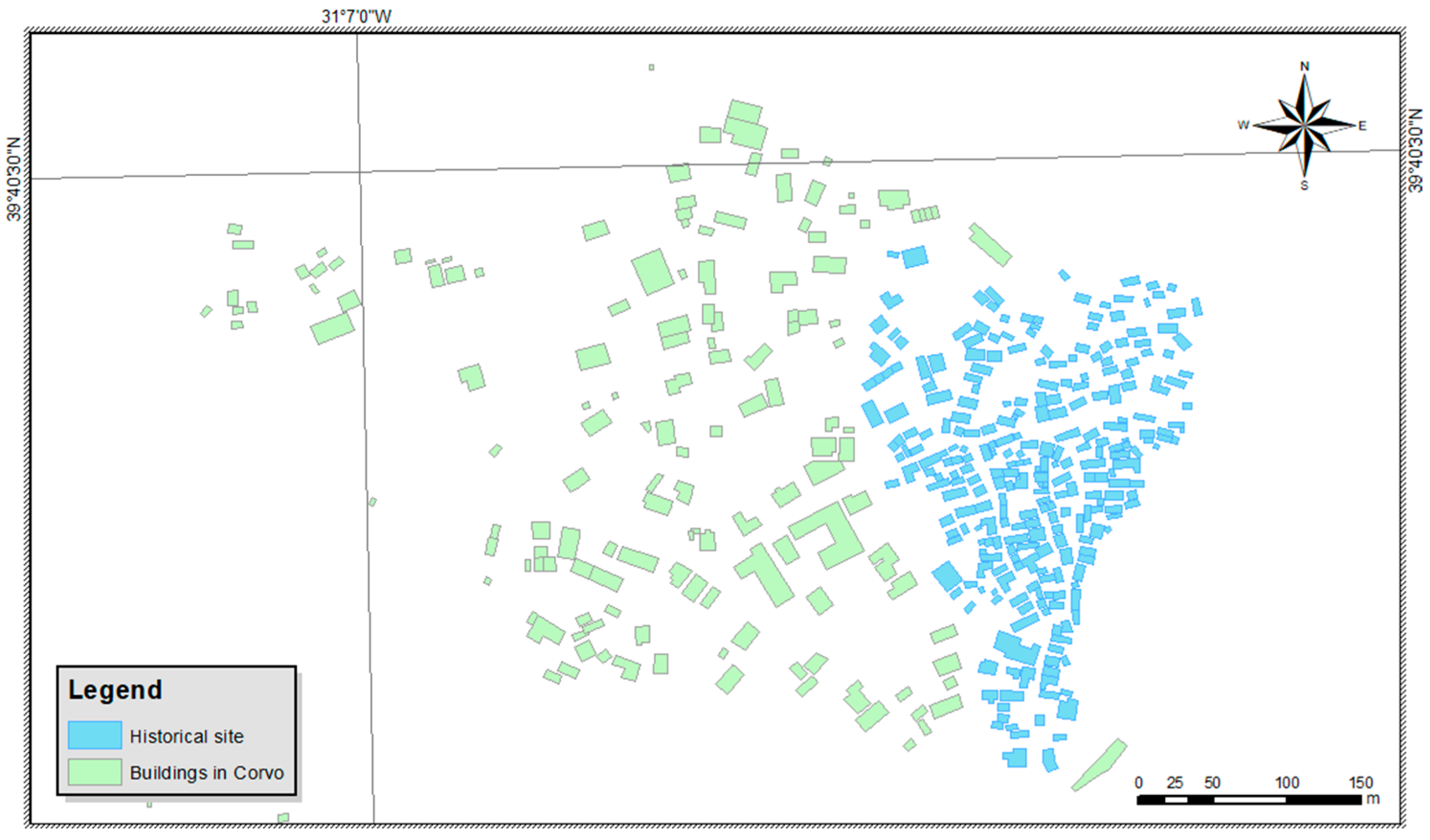
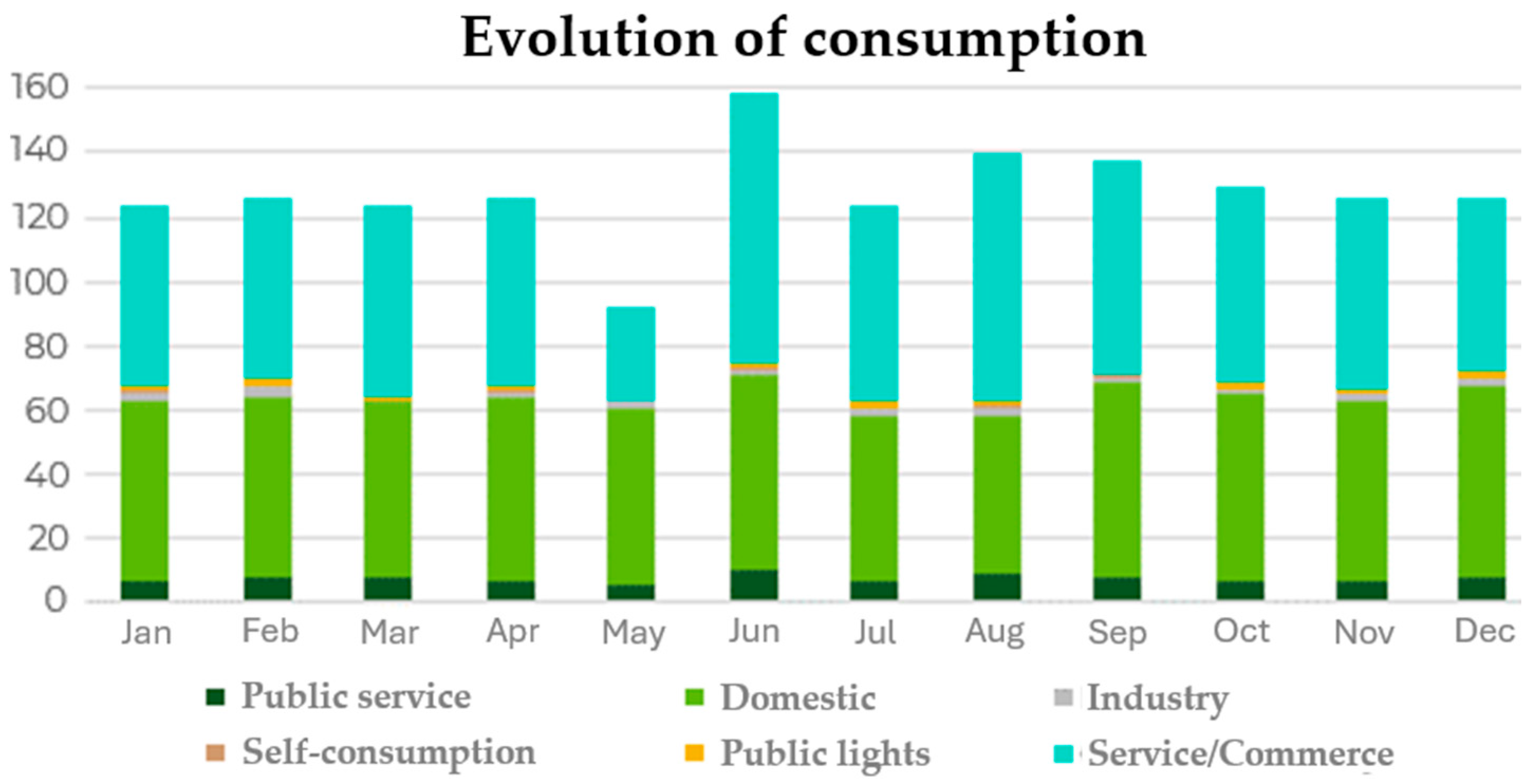
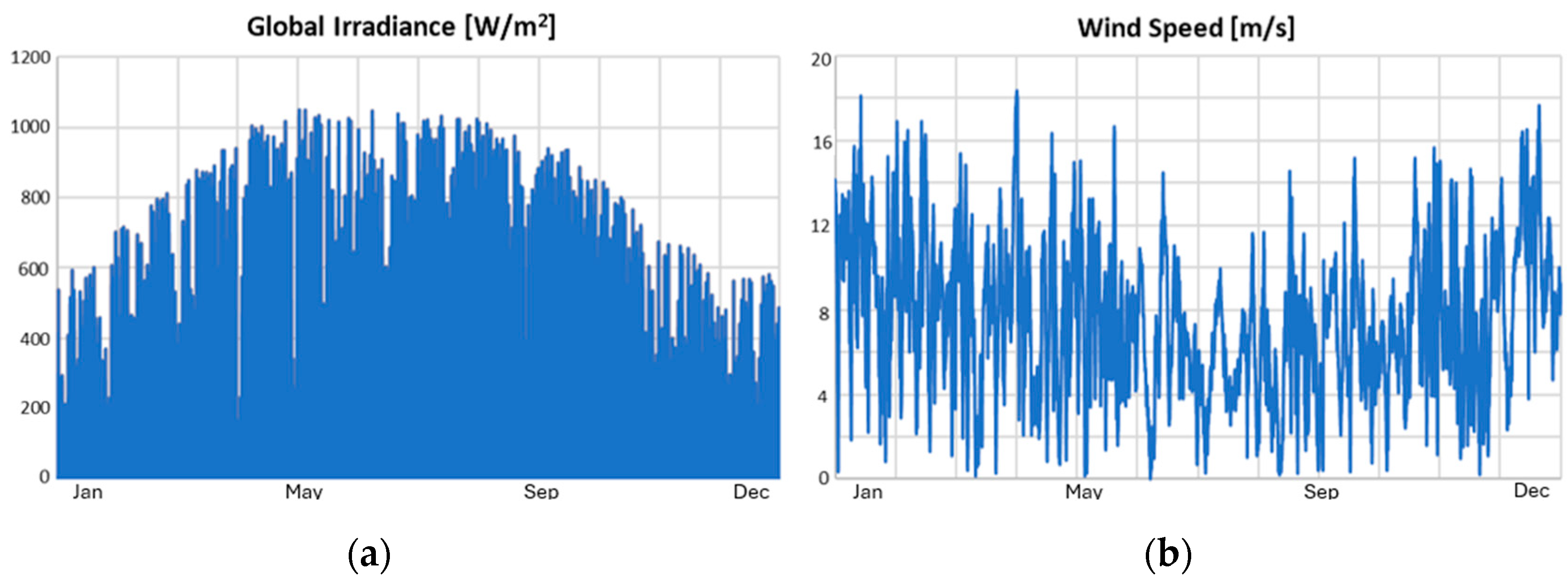
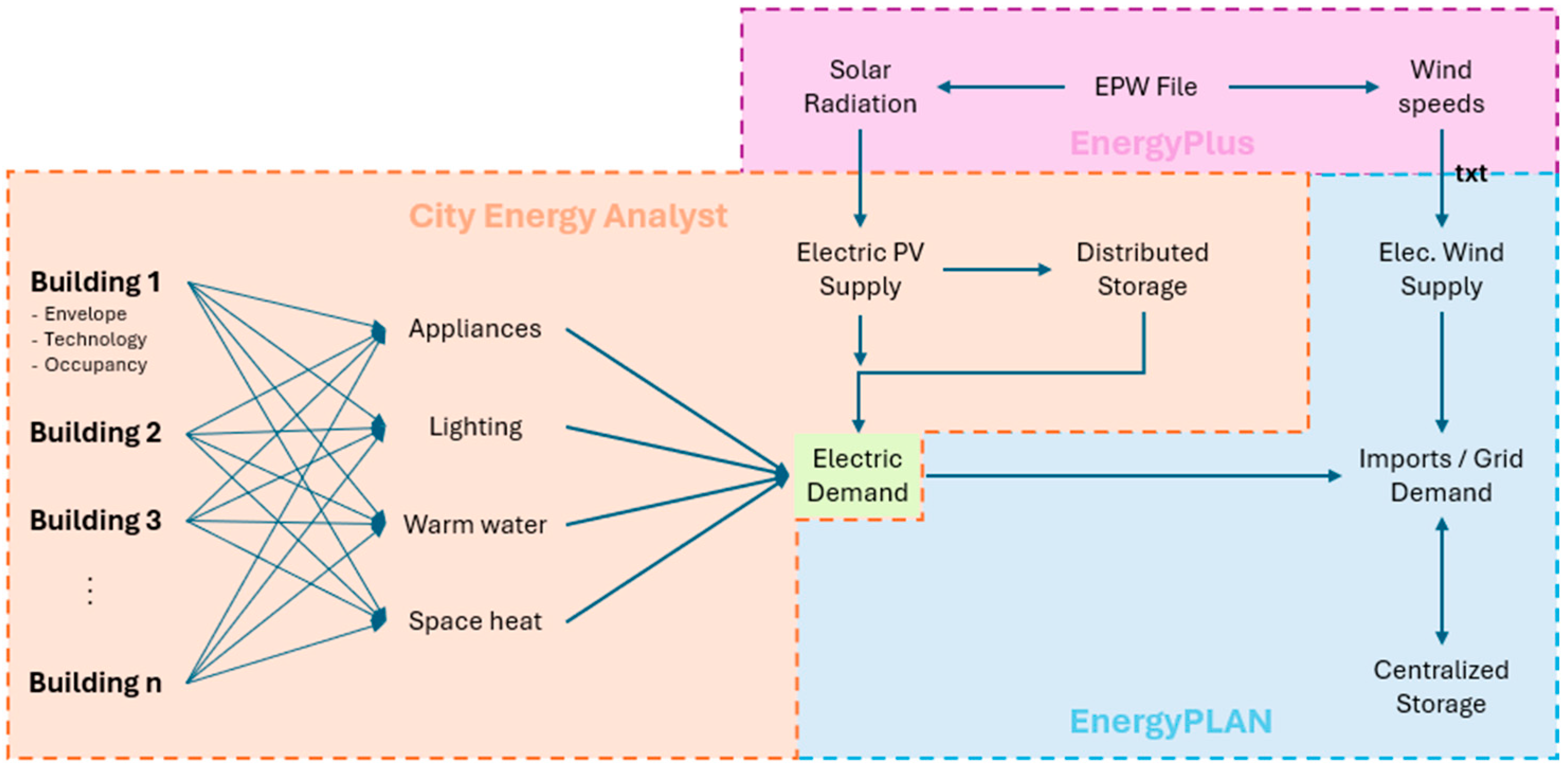
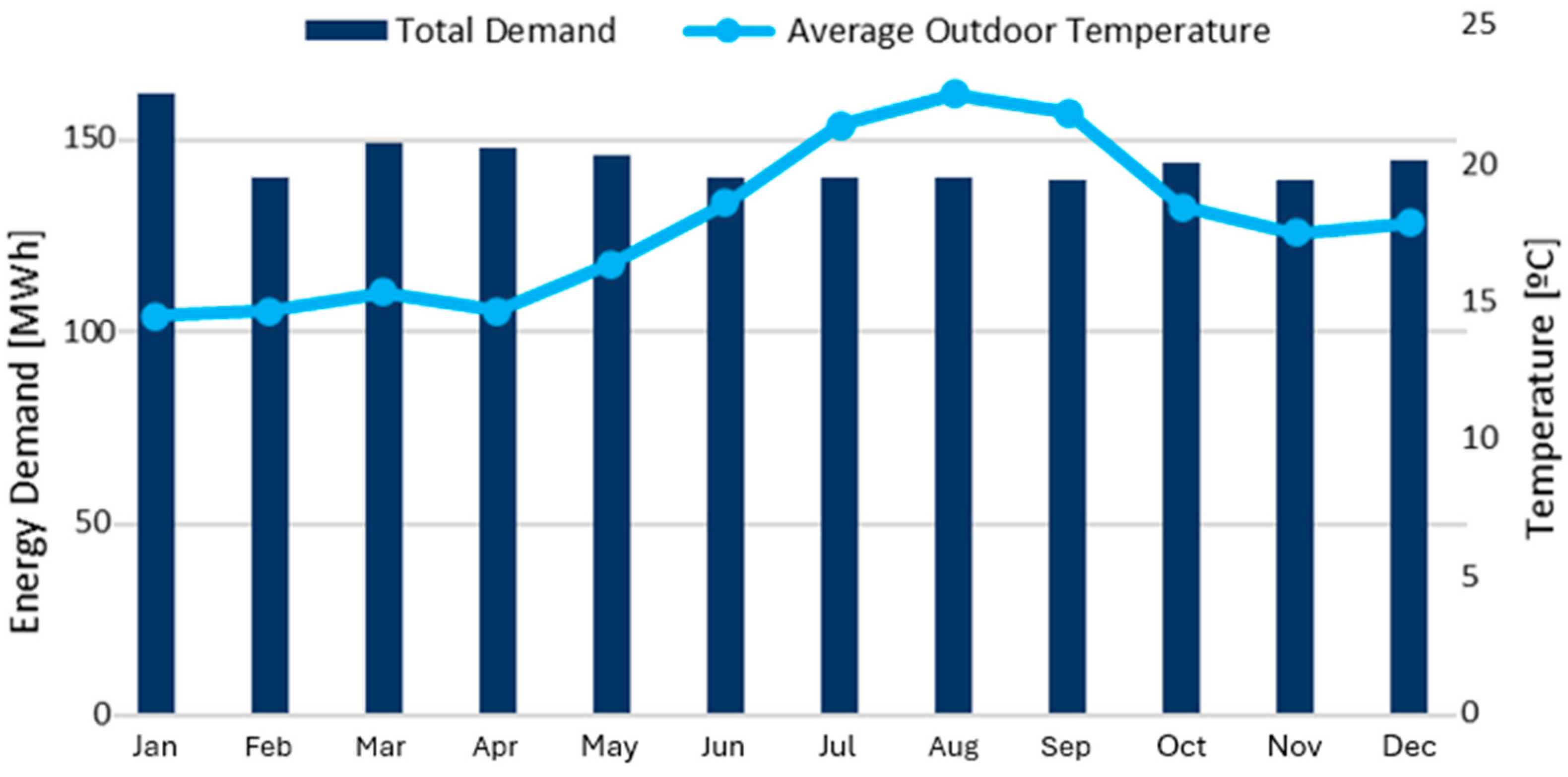
| Sector | Type | No | % | Type | No | % |
|---|---|---|---|---|---|---|
| Households | Housing | 125 | 50 | Housing | 280 | 62 |
| Service/ Commerce | Restaurant | 2 | 8 | Office | 20 | 10 |
| School | 1 | |||||
| Commerce | 3 | Restaurant | 3 | |||
| Hospital | 3 | |||||
| Services | 5 | Food store | 5 | |||
| Library | 6 | |||||
| Public equipment | 5 | Church | 1 | |||
| Museum | 3 | |||||
| Religious | 5 | Religious | 2 | |||
| Industrial | - | - | - | Industrial | 3 | 1 |
| Parking/Storage | Storage house | 25 | 10 | Parking | 44 | 10 |
| Ruin/Unoccupied | Unoccupied | 80 | 32 | Ruin | 79 | 21 |
| TOTAL | 250 | 56 | Total | 450 | ||
| Source: | Salvador et al. [21] | CEA Model | ||||
| Parameters | Value | Unit |
|---|---|---|
| Potential used | 100 | % |
| Power capacity | 13.5 | kWh/p |
| Rated voltage | 60 | V |
| C-rate | 1 | C |
| Maximum discharge | 100 | % |
| Charge/Discharge eff. | 98 | % |
| Building Type | Consumption [MWh/year] | % | Group | EDA | % Diff. |
|---|---|---|---|---|---|
| Single residential | 982.90 | 56.6 | 982.9 | 679.4 | +30.9 |
| Office | 215.40 | 12.4 | 652.9 | 826.3 | −26.6 |
| Hospital | 137.34 | 7.9 | |||
| Food store | 102.25 | 5.9 | |||
| School | 61.22 | 3.5 | |||
| Hotel | 51.85 | 3.0 | |||
| Restaurant | 40.41 | 2.3 | |||
| Church | 22.97 | 1.3 | |||
| Museum | 14.93 | 0.9 | |||
| Library | 6.51 | 0.4 | |||
| Industry | 100.32 | 5.8 | 100.3 | 21.26 | +78.8 |
| Parking | 0.0 | 0.0 | - | - | - |
| Ruin | 0.0 | 0.0 | |||
| TOTAL | 1736.1 | 1736.1 | 1532.7 | +13.27 |
| Results | Value | Unit |
|---|---|---|
| Photovoltaic panels | ||
| Installed area | 12,529.6 | m2 |
| Installed power | 2.506 | MW |
| Total production | 2.44 | GWh/year |
| Storage battery banks | ||
| Installed capacity | 15.7 | MWh |
| Energy deficit | 501.95 | MWh/year |
| Excess energy | 1147.61 | MWh/year |
| Parameters | EnergyPLAN | CEA Setup | Synergy | Unit |
|---|---|---|---|---|
| Electric demand | 1.74 | 1.74 | 1.74 | GWh/year |
| PV system capacity | 5500 | 2500 | 2100 | kW |
| PV production | 8.01 | 3.64 | 2.05 | GWh/year |
| Wind power capacity | - | - | 350 | kW |
| Wind production | - | - | 1.27 | GWh/year |
| Storage capacity | 7.90 | 15.70 | 7.90 | MWh |
| Imports | 0 | 0.16 | 0 | GWh/year |
| CEEP | 6.06 | 1.89 | 1.51 | GWh/year |
Disclaimer/Publisher’s Note: The statements, opinions and data contained in all publications are solely those of the individual author(s) and contributor(s) and not of MDPI and/or the editor(s). MDPI and/or the editor(s) disclaim responsibility for any injury to people or property resulting from any ideas, methods, instructions or products referred to in the content. |
© 2024 by the authors. Licensee MDPI, Basel, Switzerland. This article is an open access article distributed under the terms and conditions of the Creative Commons Attribution (CC BY) license (https://creativecommons.org/licenses/by/4.0/).
Share and Cite
Cevallos-Sierra, J.; Pinto Gonçalves, A.; Santos Silva, C. Using Urban Building Energy Models for the Development of Sustainable Island Energy Systems. Energies 2024, 17, 3135. https://doi.org/10.3390/en17133135
Cevallos-Sierra J, Pinto Gonçalves A, Santos Silva C. Using Urban Building Energy Models for the Development of Sustainable Island Energy Systems. Energies. 2024; 17(13):3135. https://doi.org/10.3390/en17133135
Chicago/Turabian StyleCevallos-Sierra, Jaime, Afonso Pinto Gonçalves, and Carlos Santos Silva. 2024. "Using Urban Building Energy Models for the Development of Sustainable Island Energy Systems" Energies 17, no. 13: 3135. https://doi.org/10.3390/en17133135
APA StyleCevallos-Sierra, J., Pinto Gonçalves, A., & Santos Silva, C. (2024). Using Urban Building Energy Models for the Development of Sustainable Island Energy Systems. Energies, 17(13), 3135. https://doi.org/10.3390/en17133135







